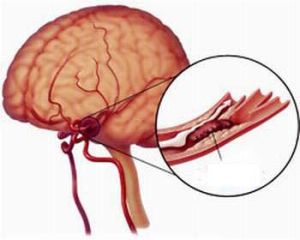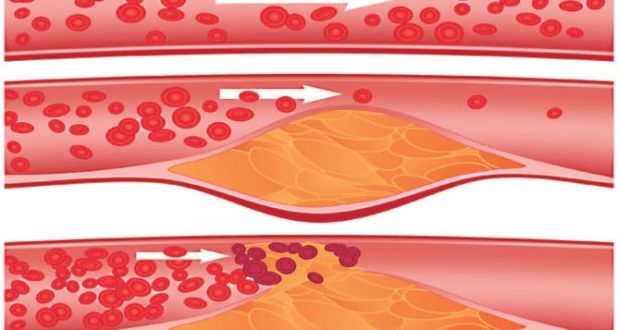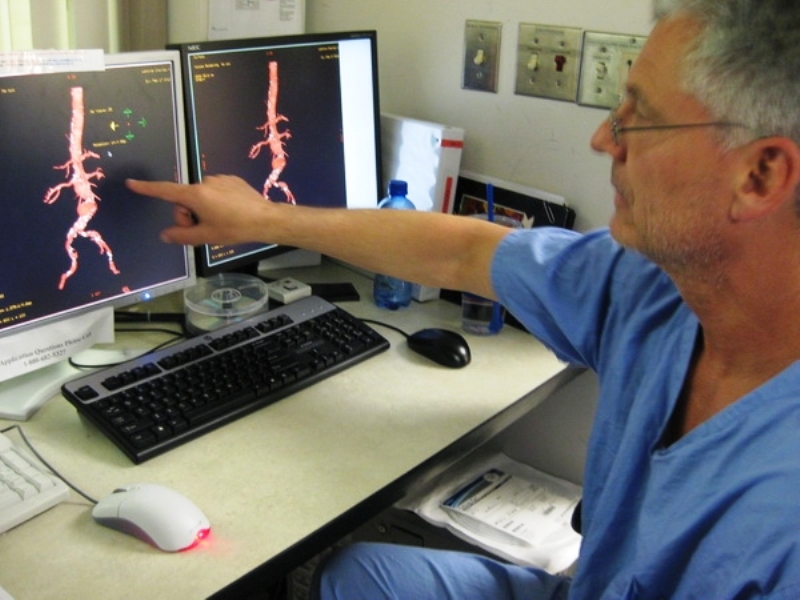How to treat atherosclerosis?
Author Ольга Кияница
2018-11-30
Atherosclerosis occurs against the background of a decrease in the elasticity of the arteries and their subsequent contraction. This process is quiet and slow, so the consequences of blocking the vessel and circulatory disorders may be sudden.
Atherosclerosis is the most common cause of myocardial infarction, stroke and peripheral vascular disease. These pathological conditions together form a group of atherosclerotic lesions of the heart and blood vessels.
The development of atherosclerosis is closely related to certain risk factors. There are also predisposing conditions by sex and age. Yet this life-threatening process can be prevented with effective treatment.
Video: How to effectively treat atherosclerosis? Atherosclerosis - Symptoms and Causes!
Description of Atherosclerosis
Atherosclerosis has a direct connection with damage to the inner layer of the vessel wall (endothelium). This can contribute to high blood pressure, smoking, or an increased amount of cholesterol in the blood. Disruption of the structure of the endothelium causes the formation of fat-like deposits in the form of plaque.
When “unhealthy” cholesterol, or low density lipoprotein (LDL), is located near the damaged endothelium, it penetrates the arterial wall. This causes leukocytes to be involved in a developing inflammatory reaction. Such a process can go unnoticed for many years, as a result of which cholesterol and leukocyte cells turn into plaques. They gradually grow in the endothelium and often protrude into the lumen of the vessels.
Plaques cause hardening and destruction of artery walls, which cease to fully expand and contract. As atherosclerosis develops, the site of the lesion increases, due to which the vessel may overlap with protruding parts of the plaque.
This leads to thrombosis, which is more susceptible to vessels of medium and small caliber. Also, a similar pathological process spreads throughout the body, often damaging vital organs (heart and brain). As a result, not only myocardial infarction can occur, but also stroke and other health problems.
Atherosclerosis does not usually cause symptoms until middle or older. But as vasoconstriction and disease progresses, it may disrupt the blood flow to a greater or lesser degree, leading to pain. The blocking plaque can also suddenly burst.This contributes to the concentration of blood, its accumulation inside the artery at the site of rupture and the formation of a blood clot.

Types of atherosclerotic plaque development
The course of atherosclerosis is different, and in each case, individually selected treatment is used.
- Atherosclerotic plaque does not extend beyond the artery wall, where it grows to a certain size and stops. Since this plaque does not block blood flow, it is almost incapable of causing the development of any symptoms.
- In another embodiment, the plaque grows slowly, so this process can be controlled, especially the quality of blood flow.Yet in the end, this process causes significant blockage of the vessels. Pain in the chest or legs, most often during physical activity, is a common symptom of this condition.
- The most unfavorable development of atherosclerotic plaque occurs when there is a sudden rupture of the pathological formation, which contributes to the thickening of the blood inside the artery. It causes a stroke in the brain; in the heart - myocardial infarction.
The most dangerous cardiovascular diseases that develop due to atherosclerosis are as follows:
- Coronary disease - the defeat of the arteries of the heart with atherosclerosis causes angina (chest pain). Full or partial detachment of the plaque along with increased blood clotting leads to a heart attack (necrosis) of the heart muscle. Most often this is how a heart attack develops.
- Cerebrovascular disease - torn plaques in the arteries of the brain lead to a blockage of blood vessels and the bleeding of some part of the brain - a stroke. Temporary blockages in the arteries can cause transient ischemic attacks (TIAs), which are warning signs of a stroke. However, in TIA, there is no trauma to the brain tissue.
- Peripheral vascular disease - due to narrowing of the arteries of the legs due to the development of plaque, which causes poor blood circulation. As a result, the patient becomes difficult to endure physical exertion. This also leads to wounds (trophic ulcers) that do not heal well or badly. Severe illness can lead to partial or complete amputation of the leg.
Causes and risk factors
The disease can begin at an early age. In some cases, the first changes at the histological level are determined in newborns. Also today, a large number of young people with no symptoms have signs of atherosclerosis. For example, a study of 262 clinically healthy people in 2001 produced the following results:
- 52% had slight atherosclerosis;
- 85% of those under 50 years of age had laboratory changes characteristic of the disease;
- atherosclerotic disorders were also noted in 17% of adolescents.
Symptoms of cardiovascular disease were all absent, with very few having severe narrowing in some arteries. It was a very early stage in the development of the disease, for the detection of which special tests were used.
After 40 years, even with good health, there is a 50% chance of developing serious atherosclerosis. The risk of its occurrence increases with age. Most adults over 60 years of age have some manifestations of atherosclerosis, but most often, no noticeable symptoms are detected.
It is important to know that the death rates from atherosclerosis over the past three decades have decreased by 25%. This is due to improved lifestyle and quality of treatment.
Major risk factors for atherosclerosis
There are three risk factors most likely to cause atherosclerosis:
- increased amount of cholesterol in the blood;
- high blood pressure (BP);
- smoking.
The table, which shows the dependence of the probability of developing atherosclerosis on the number of risk factors
| Risk factors | The probability of developing heart disease, in% |
| Presence of 1 main risk factor | thirty% |
| High cholesterol + high blood pressure | 300% |
| High cholesterol + smoking | 350% |
| High blood pressure + smoking | 350% |
| Smoking + high blood pressure + high cholesterol | 720% |
If age or other predisposing conditions are added to the main risk factors, then the likelihood of atherosclerosis increases even more.
Answers to frequently asked questions
What is the best way to treat atherosclerosis?
The most favorable and effective treatment of atherosclerosis is carried out at an early stage of its development. This type of therapy is also called prophylactic. Since risk factors underlie more than 90% of all heart attacks, one should start with correcting them or eliminating them completely:
- It is necessary to refuse to accept smoked products.
- It should reduce the level of cholesterol in the blood.
- It is important to control the height of blood pressure.
- If you have diabetes, you need to treat it.
- It is highly desirable to keep your body weight within normal limits.
- It is necessary to avoid stressful situations.
- It is useful to eat more fruits and vegetables.
- You should completely give up alcohol or not take more than one drink per day (for women) and one or two drinks (for men).
- It is important to regularly perform workouts consistent with the general state of health.
It is enough to adhere to such changes in order to significantly reduce the chances of occurrence of cardiovascular diseases. At least so say experts studying this issue from various angles and points of view.
Lifestyle correction, reduction of risk factors that lead to atherosclerosis, can slow down or stop the pathological process.Such changes will not eliminate blockages in the vessels, but there is evidence that they reduce the risk of heart attacks and strokes.
How to treat atherosclerosis with medication?
After the occurrence of blocking of the vessel, it usually remains there. However, with the use of special medications and lifestyle changes, the growth of the plaque can be slowed down or it stops growing altogether. In some cases, with aggressive treatment, deposits on the endothelium may slightly decrease.
Medication . Taking drugs to normalize high cholesterol and high blood pressure slows down the pathological process and can even stop the development of atherosclerosis. Medication, taking into account the indications, can also reduce the risk of heart attack and stroke.
The main groups of drugs used in the treatment of atherosclerosis:
- Statins - slow down the action of the enzyme involved in the formation of cholesterol.
- Cholesterol absorption inhibitors - help reduce the amount of cholesterol absorbed in the intestine.
- Sequestrants of bile acids - they are prescribed mainly for enhanced excretion of bile acids from the intestine.
- Fibrates - they are used to reduce the concentration of LDL in the blood.
- Niacin also helps reduce the amount of “bad” cholesterol.

People with moderate or high risk — those who have had a heart attack or stroke, or who have angina — aspirin is recommended. This drug helps prevent blood clots. The only thing before you begin to receive it, you need to visit your doctor for some tests, as side effects may occur.
Doctors most often use non-invasive treatment methods, although in critical cases surgical intervention is used to open a blocked vessel or bypass the affected area:
Angiography and stenting - a method based on the use of a thin tube inserted into the artery of the leg or arm. By gradually pushing it along the vessel, doctors can get to the affected area. The whole process is carried out under the control of x-ray studies in real time. Further, a stent is installed at the site of constriction, which allows for improved blood flow.
Angioplasty and stenting . With the help of balloon angioplasty (catheters with a balloon at its end) and stenting, blocked arteries can also be opened. Stenting helps reduce symptoms, although it does not prevent further heart attacks.
Bypass surgery : Surgeons use a healthy blood vessel (often taken from the leg or chest) to bypass the blocked portion of the artery. Most often this intervention is called aorto-coronary bypass.
It is important to know that these procedures may have complications. They are usually indicated for people with severe clinical conditions or significant complications caused by atherosclerosis.
Video: Atherosclerosis Treatment Methods
How to treat atherosclerosis with home remedies?
For the prevention of atherosclerosis or its treatment at an early stage of development, traditional methods of therapy or so-called natural remedies can be used. Before using them, you should consult with your doctor.
1. Garlic
Garlic contains allicin, which is its main element, which has been found to lower LDL cholesterol. Garlic can also reduce the concentration of triglycerides, by about 20%. The reduction of triglycerides also stops the growth of plaques formed inside the blood vessels. Additionally, garlic is able to prevent the oxidation of cells in the arteries, which strengthens blood vessels. Also, some compounds in a plant can contribute to the dissolution of blood clots.
2. Turmeric
This unusual powder of southeastern origin contains curcumin. It is eight times stronger than vitamin E, a well-known antioxidant. It prevents damage to the walls of blood vessels, strengthens them and improves blood circulation in the arteries. Turmeric is widely used in Indian medicine to heal wounds, but it can also lower cholesterol, lipids and prevent blood clots from forming.
3. Spinach
Greens always have a good effect on the human body; even the color itself has a soothing effect on the eyes. Spinach, however, is a vegetable that works very well on the heart. This very nutritious product can lower blood pressure. It contains selenium, beta-carotene and manganese, which fight atherosclerosis. It is also a storehouse of neoxanthin and violaxanthin, which are anti-inflammatory compounds that support the health of blood vessels.
4. Beans
Beans are really good for health, because they contain a lot of nutrients and do not have harmful fats. It is enough to cook them properly so that they can be very tasty and, of course, nutritious. Most legumes contain a lot of potassium, so they can lower blood pressure. This happens due to the expansion of blood vessels, resulting in reduced load on the entire cardiovascular system.
5. Salmon
If the heart and blood vessels are in a precarious situation, it is recommended to avoid meat as much as possible. The reason is that proteins and other nutrients found in legumes and vegetables are more easily tolerated by the body.Although a lot of meat is too hard for the body, salmon is a very good way to support health. This variety of fish has a good balance of cholesterol, HDL and LDL. It also contains a wide range of beneficial ingredients, such as potassium, selenium, choline and pantothenic acid, which are good for the heart and blood vessels.
Potassium in salmon helps reduce the load on the cardiovascular system, because it relaxes blood vessels, so it is also called a vasodilator. The only thing you need to be careful with the content of mercury in the fish and then it can be used without any side effects.
6. Fish oil
Many people have the misconception that all fats are bad, and this is wrong. The human body needs certain good fats that ensure that all organs and systems work well. The human body especially needs a certain balance between omega-3 fatty acids.
Fish oil is the concentration of omega-3 fatty acids that can balance cholesterol levels in the body. These components also prevent the formation of plaque in the blood vessels, which is the main cause of atherosclerosis. It also reduces the risk of thrombosis, stroke or heart attack.
7. Ginger
Ginger is a very powerful spice against high levels of LDL cholesterol, thick blood and platelet aggregation. It also lowers blood pressure and prevents hardening of the arteries. Enough to use it in the diet to make the heart healthier.
8. Green tea
The freshly brewed beverage contains various healthy substances. Among them are various antioxidants. With their help, damage to arterial cells is prevented, especially in the presence of free radicals. The drink also contains polyphenols, which prevent cholesterol from entering the intestine.
9. Hawthorn
The fruit has strong antioxidant properties that protect blood vessels from plaque formation. It can also help in reducing high blood pressure and excessive cholesterol levels. This contributes to the strengthening of the heart, so hawthorn is a good way to fight atherosclerosis.
Finally
The heart is the basis of human life. If it does not function well, other organs also cannot be healthy. It is important that you take care of your own health and make necessary lifestyle changes, especially if you have high risks of atherosclerosis.
The disease can be fatal, and getting rid of it, especially when complications have arisen, can be extremely difficult. If necessary, food should be changed and increased physical activity, which as a result will allow you to live a happy and healthy life. And do not forget, before taking any medications, you need to consult with your doctor.
Video: Superdrug against cholesterol plaques. Protective Products
Similar articles

Today, one of the most common metabolic disorders is considered to be atherosclerosis. In its development, it affects protein and carbohydrate metabolism, which leads to a violation of the structure of vessels in various organs. Atherosclerosis is particularly susceptible to coronary vessels, which is severely disturbed by the activity of the heart.

According to statistics, diseases associated with atherosclerosis, occupy the first places among the most likely causes of death. The disease can develop unnoticed for a long time, but against the background of it there are frequent cases of sudden death or acute myocardial infarction. Therefore, it is very important to know why vascular atherosclerosis develops and what treatment methods exist.

Atherosclerotic plaque can form in various parts of the cardiovascular system. One of the forms of pathology is atherosclerosis of the aorta of the heart, to know what it is for everyone who has a predisposition to diseases of the heart and blood vessels. When an illness is detected, the patient is necessarily treated, which helps prevent the development of serious complications.

Снижать, уровень холестерина, это самый верный выход. Диета, больше двигаться, отказаться от масла. в стати, вы знаете, что подсолнечное масло не совсем полезная штука. Обязательно советую эваларовский концентрат рыбьего жира Омега-3 принимать, вот он уровень холестерина в норме поддерживает и сердечно сосудистую систему. К тому же дозировка хорошая, не нужно по нескольку капсул за раз глотать.